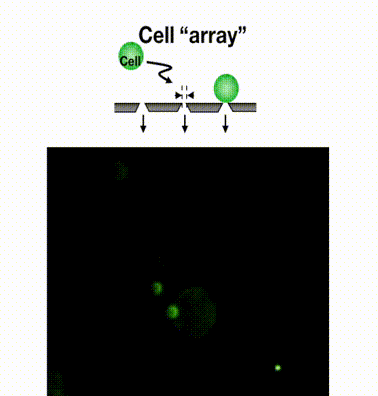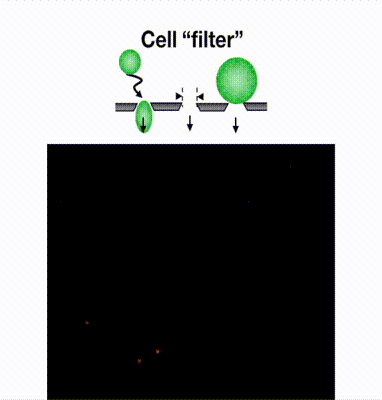Tokyo University of Agriculture and Technology Biomolecular Engineering & Marine Biotechnology Lab.
Liquid biopsy
Circulating tumor cells (CTCs)
Cancer is a disease that leads patients to death by repeating metastasis. In recent years, it has been known that different cancer cells also possess different properties, and single-cell analysis is necessary. Circulating tumor cells (CTCs), which are cells involved in cancer metastasis, invade blood vessels from cancer tissues and travel around the whole body. CTCs are anticipated as the effective biomarkers in “liquid biopsy”, a cancer diagnosis that uses blood. However, CTCs are very rare cells that only exist in the ratio of about 1-100 over 5 billion blood cells in 1ml of blood, so the technology to efficiently recover CTCs from blood was necessary for this analysis.

CTC recovery technology through microcavity array (MCA)
So far, we have developed a filtering device called microcavity array (MCA). MCA has tiny holes with the diameter of a few μm arranged at equal intervals, through which it can suck cells and arrange (array) them densely. We thought it was possible to recover CTCs using MCA. This is because CTCs are larger in size than red blood cells and white blood cells, and they do not deform easily. We examined the size, shape and number of holes suitable for CTC recovery, and succeeded in developing an MCA that could recover cancer cells at a recovery rate of more than 95% from simulated samples, in which cancer cells were mixed with the blood of healthy donor. Currently, we are developing an automated recovery system for blood cancer cells to achieve the practical application of this technology, and are conducting joint clinical trials with medical institutions. In addition, we are developing an MCA for the recovery of white blood cells and microorganisms.



Development of single-cell isolation technology using hydrogel
In order to evaluate the properties of CTCs in detail, it is necessary to isolate the CTCs one by one and analyze their genome and transcriptome (the general term for intracellular mRNAs). However, the conventional technology involved a large device and very complicated procedure to isolate one cell. Therefore, in order to isolate CTCs recovered with MCA easily, we considered embedding the cells in a gel of a size visible by raw eyes. By using photopolymerizable hydrogel (a hydrogel that solidifies when irradiated with light of a specific wavelength), we succeeded in selectively embedding only 1 cell, and the handling of a single cell with a tweezers was made possible. Currently, in collaboration with medical institutions, we are working on CTC isolation from the blood of cancer patients, and the verification tests of genetic analysis. In addition, as this technology enables single-cell analysis without involving any special technique and equipment, we are also investigating its application on cells other than CTCs.
